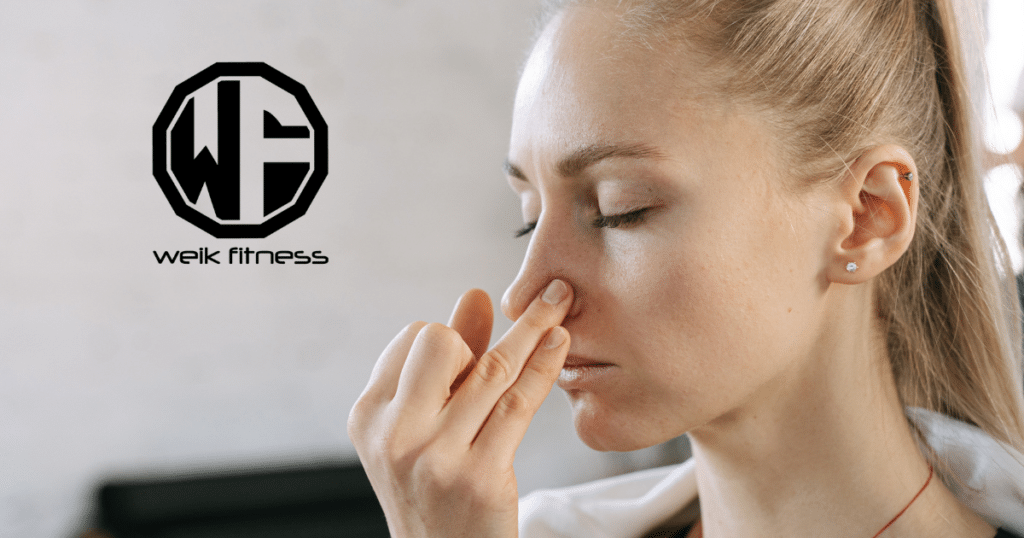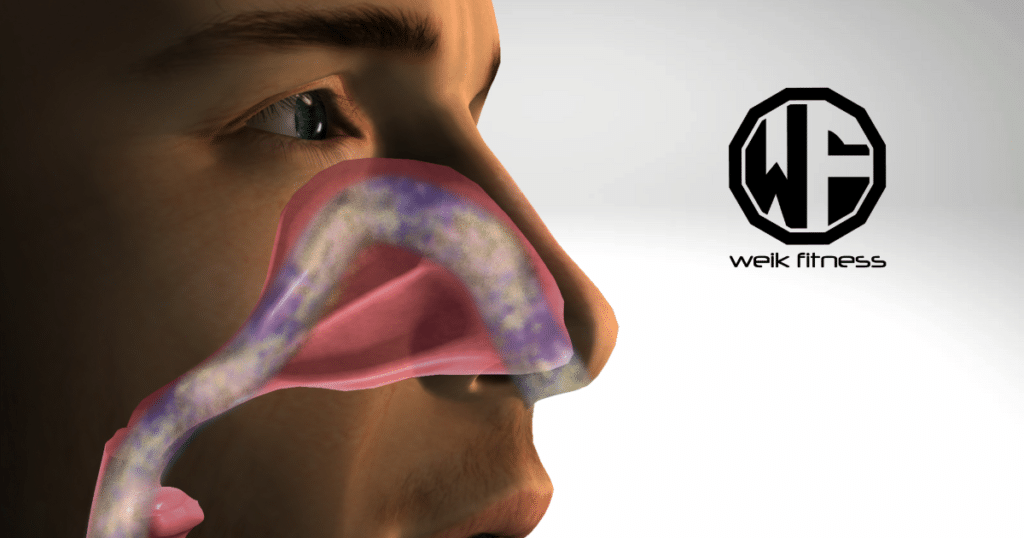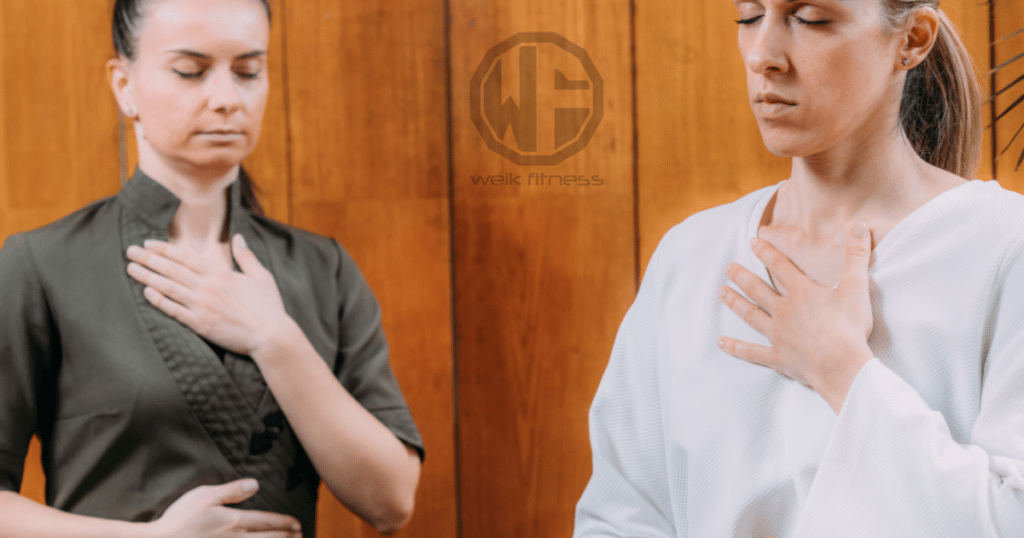Nose Breathing: The Unbelievable Benefits of Nasal Breathing
Nose breathing, what a novel concept, right? I’m sure you’re raising an eyebrow, wondering what the heck I’m talking about and why I’m spending the time publishing an article on nasal breathing, but I am.
Why?
It’s simple, there are a bunch of benefits of nose breathing that not many people actually know. There’s a difference between nasal breathing and mouth breathing.
Let’s look at it this way… Struggling to catch your breath during a workout or waking up with a parched mouth is more common than you might think. It’s easy to fall into breathing patterns that don’t quite support our bodies the way they should, often without even noticing it.
That realization hit me personally as I noticed how mouth breathing was impacting my sleep and exercise performance.
Starting this journey taught me something crucial: Breathing through the nose can actually enhance oxygen absorption far better than mouth breathing ever could. This revelation took me down a rabbit hole, looking for research on the topic, uncovering findings that were not only fascinating but also incredibly promising for nasal breathing.
Nose breathing doesn’t just benefit our physical health, it works wonders for our psychological well-being, too.
Let’s dive deeper and understand nasal breathing versus mouth breathing and discover the remarkable benefits your nose holds for your overall wellness. Get ready to transform the way you breathe — and feel — day in and day out.
Disclaimer: This article is for informational purposes only and is not meant to treat or diagnose any condition. It is recommended that you speak with your doctor before starting any exercise program, changing your daily nutrition, or adding any supplements to your regimen.
Table of contents
- Key Takeaways
- Understanding Nose Breathing
- Physical Effects of Nose Breathing
- Health Benefits of Nose Breathing
- Psychological and Cognitive Effects of Nasal Breathing
- Benefits of Nose Breathing for Physical Activity
- Implementing Effective Nose Breathing Techniques and Breathing Exercises
- Addressing Common Airway and Nose Breathing Concerns
- Nose Breathing and Mouth Breathing Are NOT the Same
- Nose Breathing Resources
Key Takeaways
- Breathing through your nose can absorb more oxygen than mouth breathing, improving lung health and reducing the risk of respiratory conditions.
- Nasal breathing helps lower blood pressure, enhances heart rate variability, and may reduce the risk of cardiovascular disease.
- Practicing nasal breathing techniques like diaphragmatic and alternate nostril breathing can increase calmness, improve sleep quality, boost concentration and memory, and enhance physical performance.

Understanding Nose Breathing
Nose breathing involves inhaling and exhaling through the nose. It’s the primary mode of breathing for humans and serves essential functions in respiratory processes.
Definition and Basic Mechanisms
Breathing through my nose changed my life, and it can change yours. It does more than just fill my lungs with air.
The process starts when I inhale air through my nostrils. This isn’t any ordinary breath. My nose filters, heats, and humidifies the air, making it cleaner and warmer before it hits my lungs.
Think of it as nature’s air purifier that protects me from dust and allergens every single day.
Here’s how the magic happens: each time I take a breath in, my diaphragm — that’s a major muscle under my lungs — gets to work. It contracts and flattens out, creating more space in my chest cavity.
This action sucks air into my lungs like a vacuum for inhalation. When exhaling, this same muscle relaxes and helps push the used air out of my body. Yes, all this complex activity just so I can take one simple breath through the nose!
Benefits of Breathing: Nose Breathing vs. Mouth Breathing
I’ve conducted a detailed comparison between nose breathing and mouth breathing.
This comparison is crucial, especially given the surprising fact that more than half of adults in the U.S. identify as “mouth breathers” or “oral breathing.”
Let’s explore the differences and understand why nasal breathing can be transformative for our health and fitness versus when you breathe through the mouth. Whether you breathe through your nose or mouth can have several benefits or constraints.
| Aspect | Nose Breathing | Mouth Breathing |
|---|---|---|
| Respiratory Muscle Engagement | Engages more respiratory muscles during inhalation when people breathe through their nose. | Decreases diaphragm muscle expansion and respiratory muscle activity when you breathe through your mouth. |
| Oxygen Absorption | Increases the body’s oxygen intake by allowing the lungs to take in more oxygen and push out carbon dioxide. | Can lead to shortness of breath, impacting the amount of oxygen intake and oxygen consumption negatively. |
| Health Impacts | Reduces the risk of respiratory conditions, supports better sleep patterns, and increases heart rate variability. | May result in tooth decay, and gum disease, and can lead to speech disorders in children. |
| Physical Performance | Improves endurance and performance, and optimizes energy usage. | Mouth breathing during exercise limits physical endurance and performance due to decreased oxygen absorption. |
I find it intriguing how our deep breathing methods can influence so much of our health and well-being.
Nasal breathing clearly stands out as the preferred choice for not only enhancing physical performance but also for safeguarding our health. It’s quite remarkable to think that something as automatic as breathing can have such a profound impact on our lives. From increasing oxygen absorption and improving lung function to reducing the risk of several health issues, the benefits of nose breathing are too significant to ignore.
Yet, many of us continue to breathe through our mouths, often without realizing the potential negative impacts. Transitioning from mouth-to-nose breathing might take some effort, but the rewards, as I’ve learned, are well worth it.
There are actually some products you can purchase to help breath better through your nose, such as these:
Physical Effects of Nose Breathing

Nasal breathing enhances oxygen absorption. It also regulates blood pressure, improving lung function.
1. Enhances Oxygen Absorption
Breathing through my nose changed how I absorb oxygen, and here’s why. The air flowing through the nostrils imposes about 50 percent more resistance than mouth breathing does. This might sound like a bad thing, but it’s actually beneficial.
Because of this resistance, my body absorbs 10 to 20 percent more oxygen. It felt like giving my lungs a better workout every time I breathed in.
I used to breathe through my mouth during exercise and thought that was efficient. Yet, switching to nasal-only breathing made a big difference in my performance and energy levels.
Engaging the respiratory muscles more effectively meant getting more oxygen into my bloodstream with each breath. This switch wasn’t just about feeling better; it was about scientifically optimizing what nature already equips us with — my nose also releases nitric oxide, which plays a key role in increasing airflow and oxygen absorption in the lungs.
2. Regulates Blood Pressure
Nose breathing has been found to have a positive impact on blood pressure. Studies discovered that nasal breathing led to a decrease in diastolic blood pressure among young adults.
Furthermore, it was observed that nasal breathing shifted the nervous system to a more relaxed state at rest, which contributed to an overall regulation of blood pressure. New research also indicates that nasal breathing is linked with lower heart disease risk and reduced blood pressure.
Additionally, cardiovascular disease stands as the leading cause of death in the U.S., underlining the significance of regulating factors such as blood pressure through practices like nasal breathing.
In a particular study focusing on 20 young adults, measurements were taken relating to their blood pressure, oxygen levels, and heart rate during different modes of respiration — highlighting notable differences favoring nose breathing over mouth breathing.
3. Improves Lung Function
Nasal breathing plays a pivotal role in enhancing lung function. By bringing air through the nose, it optimizes oxygen absorption by up to 20% compared to mouth breathing. This practice also regulates blood pressure and significantly improves overall lung performance.
Furthermore, nose breathing effectively humidifies inspired air, making it more soothing for the lungs while aiding in maintaining respiratory health.
I personally experienced considerable improvements in my lung function after transitioning from mouth to nasal breathing during physical activities such as running and yoga. Within weeks of adopting this method, I noticed enhanced endurance and an overall improvement in my respiratory well-being.
Health Benefits of Nose Breathing

Nasal breathing enhances oxygen absorption and reduces the risk of respiratory conditions. It also supports better sleep patterns and increases heart rate variability.
1. Reduces Risk of Respiratory Conditions
Nose breathing helps reduce the risk of respiratory conditions like asthma and sleep apnea. It relaxes airways, lowers blood pressure, and enhances oxygen absorption. These factors contribute to better lung function and decreased susceptibility to respiratory problems.
Additionally, nasal breathing is associated with reduced exercise-induced bronchoconstriction, which aids in improving ventilatory efficiency during physical activities.
By incorporating nasal breathing into my routine, I’ve experienced improved overall respiratory health. My workouts feel more efficient, and I don’t experience breathlessness as often during intense exercises.
This firsthand experience showcases the tangible benefits of incorporating nasal breathing techniques into daily life.
2. Supports Better Sleep Patterns
Nasal breathing positively impacts sleep quality, reducing the occurrence of snoring and symptoms of sleep apnea. It also promotes relaxation by regulating oxygen intake during sleep, leading to improved sleep patterns.

As a health and fitness enthusiast, I’ve experienced firsthand the benefits of nasal breathing for better sleep, which has significantly contributed to my overall well-being and physical performance.
Switching from mouth to nose breathing has shown statistically significant improvements in addressing sleeping disorders such as snoring and obstructive sleep apnea. The consistent oxygen levels maintained through nasal breathing during sleep result in more restful nights and increased daytime alertness.
These practical changes have made a notable difference in the way I approach my daily activities with enhanced energy and focus.
3. Increases Heart Rate Variability
Nose breathing has a notable effect on boosting heart rate variability, which is linked to cardiovascular health. Research indicates that nasal breathing results in lower diastolic blood pressure and increases the parasympathetic contributions to heart rate variability.
This is crucial as heart rate variability is associated with cardiovascular events, making it an important factor in maintaining overall heart health. The enhanced heart rate variability during nasal breathing signifies a more balanced autonomic nervous system response, reinforcing its significance for optimal cardiovascular function.
Moreover, studies have shown that the HF contribution was lower and the LF/HF ratio was higher during nose breathing, further emphasizing its positive impact on heart rate variability.
As a health enthusiast who prioritizes cardiovascular well-being, I’ve experienced substantial improvements by incorporating regular nasal breathing techniques into my routine. These key physiological effects highlight the significant role of nose breathing in enhancing heart rate variability and promoting overall cardiovascular health.
Psychological and Cognitive Effects of Nasal Breathing

Nasal breathing enhances calmness and decreases stress. To understand more about these incredible benefits, read on.
1. Enhances Calmness and Reduces Stress
Nose breathing has a remarkable effect on our mental well-being, promoting a sense of calmness and decreasing stress. It triggers the body to release nitric oxide, which acts as a natural relaxant for the blood vessels.
This physiological response helps in reducing anxiety and boosting mood by enhancing blood flow and circulation within the brain. Additionally, nasal breathing entrains high-frequency oscillations in the amygdala and hippocampus, leading to an increase in positive affect and overall feelings of tranquility.
My personal experience with adopting nose breathing techniques during stressful situations has shown me noticeable improvements in my ability to stay composed and focused. I have found that consciously practicing this deep method of breathing significantly diminishes my stress levels while enhancing my overall sense of calmness.
2. Improves Concentration and Memory
Nasal breathing enhances concentration and memory by synchronizing brain activity, improving cognitive performance. It influences recognition memory through the modulation of fear-related response times, thereby enhancing overall mental focus.
Additionally, nose breathing improves brain connections, leading to better retention and recall abilities. This makes it a valuable tool for optimizing cognitive tasks and achieving peak mental performance in various activities.
By providing a consistent flow of oxygen to the brain and regulating respiratory phases, nasal breathing supports improved concentration levels and optimized memory functions. It’s an essential technique that maximizes cognitive potential during various mental activities such as learning, problem-solving, or creative endeavors.
Benefits of Nose Breathing for Physical Activity

There are many benefits of nose breathing when it comes to physical activity. Let’s look at some of those benefits and dive deeper.
1. Improves Endurance and Performance
Nasal breathing is great for enhancing endurance and boosting performance during physical activities. It optimizes oxygen intake, allowing more efficient energy usage and maintaining peak performance levels.
This way of breathing also helps keep the body calm during high-intensity exercise, supporting better endurance and sustained output. I have personally experienced improved stamina and overall performance by incorporating nose breathing into my fitness routine.
RELATED: Yoga for Athletes — Boost Recovery and Sports Performance
In addition to this experience, studies have shown that nasal breathing can significantly increase oxygen absorption in active tissues, resulting in improved respiratory rates and a higher intake/exhaust ratio of oxygen.
As a result, it’s no surprise that many athletes are now turning to nose breathing as a tool to enhance their endurance and optimize their performance.
2. Optimizes Energy Usage
Nasal breathing optimizes energy usage during physical activity. It enhances oxygen absorption and reduces the need for overexertion, allowing for improved endurance and performance.
This efficient utilization of energy benefits both casual exercisers and professional athletes, leading to better overall physical output.
Additionally, studies have shown that nose breathing stabilizes the heart rate variability, promoting an optimal balance in energy consumption during physical activities.
Personally, I have integrated nasal breathing techniques into my fitness routine and have experienced increased stamina and reduced fatigue during workouts.
Implementing Effective Nose Breathing Techniques and Breathing Exercises

Mastering nasal breathing can significantly enhance your overall well-being and fitness performance.
1. Diaphragmatic Breathing
Diaphragmatic breathing is a vital technique involving deep, slow breaths through the nose while engaging the diaphragm. It’s proven to enhance attention, mood, and cortisol levels.
This method forms an essential part of practices such as yoga and Tai Chi Chuan. Research affirms that diaphragmatic breathing significantly reduces anxiety and depression in individuals with chronic pain.
Practicing this type of breathing has personally helped me manage stress better and maintain a calm demeanor during challenging situations. This simple yet effective technique can be seamlessly incorporated into daily routines to promote overall well-being.
2. Alternate Nostril Breathing
Alternate nostril breathing (ANB) is an ancient yogic technique that involves using the thumb and ring finger to close one nostril at a time while inhaling and exhaling. A study conducted on 25 male students aged 18-22 years found significant improvements in parasympathetic tone after six weeks of ANB training.
The researchers observed notable increases in the E:I ratio and 30:15 ratio, indicating positive effects on autonomic nervous system balance.
The practice of alternate nostril breathing has shown promising potential in enhancing overall wellness, making it a worthwhile addition to any health and fitness regimen.
3. Tips to Transition from Mouth to Nose Breathing
Transitioning from mouth-to-nose breathing can be advantageous for your health and fitness journey. Here are some tips:
· Practice Diaphragmatic Breathing: Start by lying on your back with one hand on your chest and the other on your stomach. Inhale deeply, making sure the hand on your stomach rises more than the one on your chest. This technique helps you engage your diaphragm and promotes nose breathing.
· Gradual Transition: Begin by consciously incorporating nose breathing during low-intensity activities like walking or light cardio. Slowly increase the duration of nasal breathing during these exercises to acclimate your body.
· Alternate Nostril Breathing Exercise: This technique involves inhaling through one nostril and exhaling through the other, promoting balanced airflow through both nostrils.
· Mindfulness Techniques: Use mindfulness practices to focus on nasal breathing throughout the day. Take a few minutes to close your eyes and pay attention to the sensation of air flowing in and out of your nostrils.
· Seek Professional Guidance: Consult a health professional or a breathing specialist who can provide personalized guidance for transitioning from mouth to nose breathing, especially if you have underlying respiratory conditions.
Remember, adopting nasal breathing is not merely about physiological adjustment but also an opportunity for holistic well-being.
Addressing Common Airway and Nose Breathing Concerns

For those experiencing nasal congestion, using a saline nasal spray or practicing steam inhalation can help alleviate the issue. To manage dry mouth during sleep, staying well-hydrated throughout the day and using a humidifier in the bedroom can be beneficial.
1. Dealing with Nasal Congestion
When experiencing nasal congestion, try this enhanced breathing technique known as the “Alternate Nostril Breathing” (ANB), which may alleviate this discomfort. ANB involves inhaling and exhaling through one nostril at a time, clearing and opening nasal passages for better airflow.
Here’s how ANB can help address nasal congestion:
1. ANB directs the flow of air through each nostril, promoting the release of nitric oxide, which reduces inflammation and improves blood circulation in the nasal passages.
2. By allowing increased airflow through congested nostrils, ANB assists in relieving pressure and alleviating sinus discomfort.
3. The deliberate focus on deep, slow breathing during ANB aids in calming the nervous system, reducing stress levels, and helping to clear blocked sinuses.
4. Practicing ANB regularly can enhance overall respiratory well-being by training the body to breathe more efficiently through the nose instead of relying on mouth breathing.
5. Additionally, incorporating essential oils such as eucalyptus or peppermint during ANB sessions may provide added relief by further opening nasal airways and enhancing the decongestant effect.
6. Remember that nasal congestion is often exacerbated by environmental triggers such as allergens or irritants, so creating an environment with clean air using air purifiers or humidifiers can support long-term relief from congestion.
2. Managing Dry Mouth During Sleep
Below are some techniques I want to share that can help manage dry mouth during sleep.
1. Stay Hydrated: Drink water regularly throughout the day and before bed.
2. Use a Humidifier: Keep a humidifier in your bedroom to add moisture to the air.
3. Limit Caffeine and Alcohol: These can dehydrate you, worsening dry mouth.
4. Mouth Taping: Consider using mouth tape to encourage nasal breathing and reduce dry mouth.
5. Saliva Stimulants: Sugar-free lozenges or gum can help stimulate saliva production.
6. Oral Care Routine: Maintain good oral hygiene with regular brushing and flossing.
Remember, managing dry mouth involves staying hydrated, creating a moist environment, and being mindful of lifestyle habits and medications used.
Nose Breathing and Mouth Breathing Are NOT the Same

Nose breathing has incredible benefits for our overall health and well-being. Breathing through the nose filters, heats, and humidifies air, reducing the risk of developing colds or allergic reactions.
It also supports better sleep patterns and increases heart rate variability. Implementing effective nasal breathing techniques such as diaphragmatic breathing and alternate nostril breathing can help us transition from mouth to nose breathing and enjoy these remarkable advantages.
The physical effects of nose breathing enhance oxygen absorption, regulate blood pressure, and improve lung function. Furthermore, it offers psychological and cognitive effects by enhancing calmness, reducing stress, improving concentration, and memory.
Moreover, nasal breathing is beneficial for physical activity; it optimizes energy usage while improving endurance and performance.
By practicing proper nose breathing techniques, we can experience numerous health benefits that support both our physical and mental well-being. So, let’s prioritize nasal breathing in our daily lives to unlock these amazing advantages!
If you want to improve nose breathing, consider trying these recommended products:
Nose Breathing Resources
- https://www.healthline.com/health/nose-breathing
- https://pmc.ncbi.nlm.nih.gov/articles/PMC5466403/
- https://pmc.ncbi.nlm.nih.gov/articles/PMC10858538/
- https://www.lenus.ie/bitstream/handle/10147/559021/JAN15Art7.pdf
- https://www.physiology.org/detail/news/2024/01/17/nose-breathing-lowers-blood-pressure-may-help-reduce-risk-factors-for-heart-disease
- https://boomboomnaturals.com/blogs/news/nasal-breathing
- https://pubmed.ncbi.nlm.nih.gov/37867476/
- https://pmc.ncbi.nlm.nih.gov/articles/PMC9873947/
- https://pmc.ncbi.nlm.nih.gov/articles/PMC11048276/
- https://pmc.ncbi.nlm.nih.gov/articles/PMC5148230/
- https://www.nytimes.com/2018/11/20/well/mind/breathing-through-the-nose-may-offer-unique-brain-benefits.html
- https://delreymd.com/endurance-sports-and-nasal-breathing-can-improved-nasal-breathing-help-with-performance-in-sports/
- https://pmc.ncbi.nlm.nih.gov/articles/PMC5455070/
- https://pmc.ncbi.nlm.nih.gov/articles/PMC7602530/
- https://pmc.ncbi.nlm.nih.gov/articles/PMC3681046/
- https://pmc.ncbi.nlm.nih.gov/articles/PMC8378456/
- https://pmc.ncbi.nlm.nih.gov/articles/PMC9498537/
- https://pubmed.ncbi.nlm.nih.gov/3298509/


*Disclosure: This article may contain affiliate links or ads, which means we earn a small commission at no extra cost to you if you make a purchase through these links. These commissions help support the operation and maintenance of our website, allowing us to continue producing free valuable content. Your support is genuinely appreciated, whether you choose to use our links or not. Thank you for being a part of our community and enjoying our content.
PLEASE CONSIDER SHARING THIS ON YOUR SOCIAL MEDIA TO HELP OTHERS LEARN MORE ABOUT THIS TOPIC.




